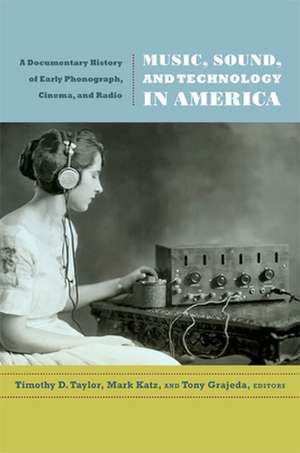Music, Sound, and Technology in America – A Documentary History of Early Phonograph, Cinema, and Radio
Autor Timothy D. Taylor, Mark Katz, Tony Grajedaen Limba Engleză Paperback – 18 iun 2012
Preț: 305.08 lei
Nou
Puncte Express: 458
Preț estimativ în valută:
58.39€ • 60.72$ • 48.86£
58.39€ • 60.72$ • 48.86£
Carte tipărită la comandă
Livrare economică 15-29 martie
Preluare comenzi: 021 569.72.76
Specificații
ISBN-13: 9780822349464
ISBN-10: 0822349469
Pagini: 432
Ilustrații: 20 illustrations
Dimensiuni: 158 x 234 x 30 mm
Greutate: 0.59 kg
Editura: MD – Duke University Press
ISBN-10: 0822349469
Pagini: 432
Ilustrații: 20 illustrations
Dimensiuni: 158 x 234 x 30 mm
Greutate: 0.59 kg
Editura: MD – Duke University Press
Recenzii
"What should we make of the strange matter of sound? From the start of human history until not so long ago, sound would have been a fleeting sign of something else, a presence or an event. Then, with the invention of contraptions like the phonograph, came a wave of recording technologies that would instill sound with a sense of permanence, as material evidence of something no longer there. Measuring the cultural importance and metaphysical weirdness of that change is part of the project of "Music, Sound, and Technology in America," an anthology of fascinating artifacts whose prosaic title belies its insights into the early years of the recorded-sound era." Andy Battaglia, Wall Street Journal, July 31st 2012
Filled with great selections, Music, Sound, and Technology in America is a salutary addition to a media studies literature lacking in such sourcebooks. It provides a ready-made trove of primary source material to use in classroom discussions of historical interpretation and methodology. In addition, by juxtaposing materials on diverse aspects of sound, the editors avoid the persistent habit of segmenting sound studies by medium or mode. Jonathan Sterne, author of The Audible Past: Cultural Origins of Sound Reproduction
Music, Sound, and Technology in America provides a useful overview of the impact of technologies on American music and musical culture. It is a valuable resource, an engaging, well-organized anthology that will raise provocative questions for students of American cultural history. Michele Hilmes, author of Radio Voices: American Broadcasting, 19221952
The editors have selected and assembled their material with perspicuity and wit, and anybody interested in the infancy of sound recording, cinema, and radio is guaranteed to experience frequent aha! moments that transport them with a simple turn of phrase to the mind-set of an earlier age. James M. Keller, Santa Fe New Mexican
"What should we make of the strange matter of sound? From the start of human history until not so long ago, sound would have been a fleeting sign of something else, a presence or an event. Then, with the invention of contraptions like the phonograph, came a wave of recording technologies that would instill sound with a sense of permanence, as material evidence of something no longer there. Measuring the cultural importance and metaphysical weirdness of that change is part of the project of "Music, Sound, and Technology in America," an anthology of fascinating artifacts whose prosaic title belies its insights into the early years of the recorded-sound era." Andy Battaglia, Wall Street Journal, July 31st 2012 "Filled with great selections, Music, Sound, and Technology in America is a salutary addition to a media studies literature lacking in such sourcebooks. It provides a ready-made trove of primary source material to use in classroom discussions of historical interpretation and methodology. In addition, by juxtaposing materials on diverse aspects of sound, the editors avoid the persistent habit of segmenting sound studies by medium or mode." Jonathan Sterne, author of The Audible Past: Cultural Origins of Sound Reproduction "Music, Sound, and Technology in America provides a useful overview of the impact of technologies on American music and musical culture. It is a valuable resource, an engaging, well-organized anthology that will raise provocative questions for students of American cultural history." Michele Hilmes, author of Radio Voices: American Broadcasting, 1922-1952 "The editors have selected and assembled their material with perspicuity and wit, and anybody interested in the infancy of sound recording, cinema, and radio is guaranteed to experience frequent 'aha!' moments that transport them with a simple turn of phrase to the mind-set of an earlier age." - James M. Keller, Santa Fe New Mexican
Filled with great selections, Music, Sound, and Technology in America is a salutary addition to a media studies literature lacking in such sourcebooks. It provides a ready-made trove of primary source material to use in classroom discussions of historical interpretation and methodology. In addition, by juxtaposing materials on diverse aspects of sound, the editors avoid the persistent habit of segmenting sound studies by medium or mode. Jonathan Sterne, author of The Audible Past: Cultural Origins of Sound Reproduction
Music, Sound, and Technology in America provides a useful overview of the impact of technologies on American music and musical culture. It is a valuable resource, an engaging, well-organized anthology that will raise provocative questions for students of American cultural history. Michele Hilmes, author of Radio Voices: American Broadcasting, 19221952
The editors have selected and assembled their material with perspicuity and wit, and anybody interested in the infancy of sound recording, cinema, and radio is guaranteed to experience frequent aha! moments that transport them with a simple turn of phrase to the mind-set of an earlier age. James M. Keller, Santa Fe New Mexican
"What should we make of the strange matter of sound? From the start of human history until not so long ago, sound would have been a fleeting sign of something else, a presence or an event. Then, with the invention of contraptions like the phonograph, came a wave of recording technologies that would instill sound with a sense of permanence, as material evidence of something no longer there. Measuring the cultural importance and metaphysical weirdness of that change is part of the project of "Music, Sound, and Technology in America," an anthology of fascinating artifacts whose prosaic title belies its insights into the early years of the recorded-sound era." Andy Battaglia, Wall Street Journal, July 31st 2012 "Filled with great selections, Music, Sound, and Technology in America is a salutary addition to a media studies literature lacking in such sourcebooks. It provides a ready-made trove of primary source material to use in classroom discussions of historical interpretation and methodology. In addition, by juxtaposing materials on diverse aspects of sound, the editors avoid the persistent habit of segmenting sound studies by medium or mode." Jonathan Sterne, author of The Audible Past: Cultural Origins of Sound Reproduction "Music, Sound, and Technology in America provides a useful overview of the impact of technologies on American music and musical culture. It is a valuable resource, an engaging, well-organized anthology that will raise provocative questions for students of American cultural history." Michele Hilmes, author of Radio Voices: American Broadcasting, 1922-1952 "The editors have selected and assembled their material with perspicuity and wit, and anybody interested in the infancy of sound recording, cinema, and radio is guaranteed to experience frequent 'aha!' moments that transport them with a simple turn of phrase to the mind-set of an earlier age." - James M. Keller, Santa Fe New Mexican
Notă biografică
Descriere
This anthology of primary documents collects material from the end of the 19th century up through World War II on the material history of sound technologies and music in America. The book is divided into three sections: on the phonograph, sound in the cinema (including musical accompaniment), and music on radio. Each section includes advertisements, articles from the popular and trade press, and other documents and primary materials, including some amusing and surprising selections. There is an introduction to each section, and a general introduction that urges readers to attend to what the selections say through their implied assumptions and audience.






